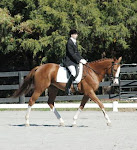 The beauty and efficiency of the posting trot is easily appreciated by all types of English style riders. But many riders and trainers - including myself - will have difficulty telling you exactly how posting became such a staple of riding or how the term "posting" came to represent the standing and sitting motion of a rider on horseback.
The beauty and efficiency of the posting trot is easily appreciated by all types of English style riders. But many riders and trainers - including myself - will have difficulty telling you exactly how posting became such a staple of riding or how the term "posting" came to represent the standing and sitting motion of a rider on horseback.
A postillion or post-boy is a term used to describe a rider mounted on a carriage horse, aiding the coachman (seated in the vehicle) in the control of the team. Occasionally, the postillion rider would control the entire team, eliminating the need for a coachman. When travel by carriage was at the height of popularity - the late 1700's to the mid 1800's - horse drawn carriages traveled from post to post, exchanging horses and post-boys for fresh ones at each stop as needed. Sitting the trot while covering all that ground in between posts exhausted the postillions backsides and the backs of their mounts. Somewhere along the line, a postillion figured out that rising out of the saddle in rhythm to the horse's trot saved much effort and soreness. I haven't been able to find any specific information on exactly which individual or group of post-boys started posting first, other than a vague nod toward the postillions who served the English royal family.
Posting Diagonals first became necessary for posting the trot in the repetitive format of the riding arena as opposed to long, straight distances such as roads and fields. Rising and sitting according to the forward movement of the inside hind leg/outside front leg helps rider balance the horse in the corners and turns. Changing the posting diagonal when changing direction ensures the rider will be posting on either diagonal pair of legs equally(assuming the rider rides an equal amount of time in both directions).
My references for this casual blurb:
Wikipedia
Fundamentals of Riding by Gregor de Romaszkan, Doubleday, 1964
Drill Regulations for Signal Troops, The US War Department, 1917
Drill Regulations for Signal Troops, The US War Department, 1917






